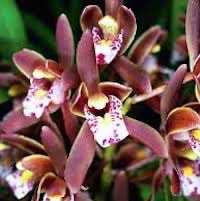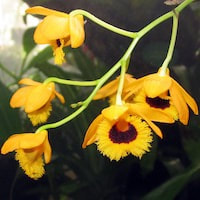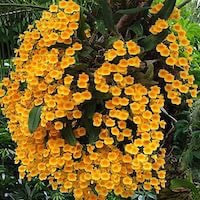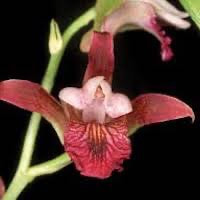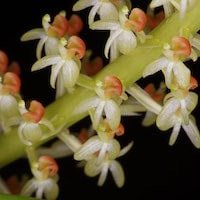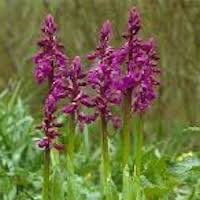WFL5 - Women's Floral 5 - Gardenia of Eden
|
Native Singaporean Orchid notes: Vanda Miss Joaquim
Vanda Miss Joaquim is a hybrid orchid made from Papilionanthe teres and P. hookeriana, and it is Singapore’s national flower. While its scent is subtle, efforts have been made to extract and enhance it for use in perfumes and team-building activities. The orchid contains anthocyanins, which are antioxidants that protect cells, and coumarin compounds, which may help with blood clotting. Although not mainly known for its fragrance, Vanda Miss Joaquim is highly valued for its cultural significance and potential health benefits.
|
Therapeutic Orchid notes:
|
Cymbidium floribundum Lindl. Syn. Cymbidium floribundum Lindl. var. pumilum (Rolfe) Y.S. Wu et S.C. Chen; Cymbidium pumilum Rolfe
Cymbidium floribundum, also known as Duohua Lan or many-flowered Cymbidium, is a type of orchid found in central and southern China. It grows as an epiphyte on trees or sometimes on rocks and soil. These orchids prefer habitats like forest edges, sunny cliffs, and ravines. They emit fragrances that attract Japanese honey bees, similar to substances in the bees' glands. While Cymbidium floribundum is used in herbal practices in regions like Huadong, Huanan, and Tibet, it's mostly admired for its beauty and its natural scent that lures bees. |
|
Dendrobium fimbriatum Hook. f. syn. Dendrobium normale Fale.
Dendrobium fimbriatum, known as Liusushihu or Mabianshihu in Chinese, fringed lip Dendrobium in India, and Ueang waew mayura or Ueang kaam ta daam in Thailand, is a fragrant orchid with medicinal uses. In Traditional Chinese Medicine, it is called shihu and is used to improve eyesight and boost immunity due to its polysaccharides and antioxidant properties. In Nepal, the whole plant treats liver issues and nervous problems. Its extracts also show potential against cancer cells, making it significant both for its beauty and medicinal benefits. |
|
Dendrobium lindleyi Steub. syn. Dendrobium aggregatum Roxb.
Dendrobium lindleyi, also known as Dendrobium aggregatum, is an orchid found across Asia with a short flowering period of about one week. This orchid grows in various environments, from forests in northeast India to Bhutan, Myanmar, southern China, Thailand, Laos, and Vietnam. In Traditional Chinese Medicine (TCM), it is called "shihu" and is used for its potential health benefits. Its wide distribution and role in TCM highlight its cultural and medicinal importance, with ongoing research exploring its therapeutic properties. |
|
Eulophia spectabilis (Dennst.) Suresh
Eulophia spectabilis, also called Beautiful Crown Orchid and Amarkand, is a terrestrial orchid found across tropical and subtropical Asia. Its pseudobulbs are used in traditional medicine for treating intestinal worms, abscesses, and infections. The orchid contains compounds that may help against breast cancer and other health issues. Its wide distribution and medicinal uses highlight its cultural and therapeutic value in various regions. |
|
Liparis condylobulbon Rchb. f. Syn. Liparis treubii J.J. Smith
Liparis condylobulbon, known as Anggrek gajang in Indonesia, is an orchid found from Myanmar and Thailand to Malaysia, Indonesia, the Philippines, and Fiji. In Sulawesi, Indonesia, people traditionally chew its young pseudobulbs and use heated leaves on the abdomen to aid digestion and relieve a bloated stomach. While these practices show the orchid's cultural and medicinal significance, more scientific research is needed to explore its active compounds and therapeutic effects. Combining traditional knowledge with modern science could reveal more about this orchid's health benefits. |
|
Orchis mascula (L.) L.
Orchis mascula, also known as the Salep Orchid or Early Purple, is an orchid found across Europe, North Africa, temperate Asia, and Siberia. In India, it is called Salab Misr or Salep Misri, and in Iran, it is known as Punjah-i-salaba. Traditionally, its tubers have been used to treat conditions like diabetes, diarrhea, and phthisis, while in Nepal, it serves as an expectorant and nutrient. The tuber is also used to make salep, a thick gel thought to be invigorating and aphrodisiacal, though more scientific research is needed to confirm these effects. |
Other scent note
Tea Rose, Carnation, Lily, Kudzu, sinfonias, Black alder, Bougainvillea, Dove tree, Dyer’s green weed, Mirabilis
Scentopia Library Reference ingredient
Rose Hip - Check details at Scentopia's scent library
Download the guided mediation that works best with this Orchid fragrance oil
| women_floral_essential_oil_orchi_00005.mp3 | |
| File Size: | 116677 kb |
| File Type: | mp3 |

